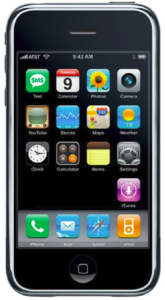
October 11, 2019
Innovation is Insufficient
3 minute read
We were recently talking with a company that had just completed a review of the most successful new products over the past three years in the categories in which they compete. From this review, they determined they had the “idea” for each of the successful new products in their innovation pipeline, but were unable to translate the idea into a successful product launch.
This is far from uncommon in our experience. Most companies come up with lots of great ideas for new products, services or businesses. Successful companies, however, are the ones that are able to turn those ideas into big and profitable businesses. While you can find examples of this across almost all industries, one of the most striking examples comes from one of the most world-changing new product categories of the past 20 years – the smart phone.
A Billion-Dollar Innovation
A multinational proudly presents the future of the mobile phone to investors and wireless carriers. A phone without buttons – except the single button that sits below a color touch screen. With this breakthrough device, a person could locate a restaurant, play a game, order a pizza, and – of course – call a friend. Sound familiar? You know the rest of the story, right? Read on.

A Billion-Dollar Business
While most people would logically conclude the previously described company was Apple in 2007, the real answer was it was Nokia in the year 2000. That’s right – Nokia had the iPhone (and iPad) designed and built 7 years before Apple launched the iPhone in 2007. Since that launch, Apple has sold more than 1 billion iPhones worldwide accounting for 69% of company sales in 2017. In contrast, Nokia’s market share dropped from 51% in 2007 to 3.1% in 2013, when its phone assets were sold to Microsoft.
What Happened
In simple terms, Nokia created a “great product” but was unable to turn that product into a “great business.” As reported in the Wall Street Journal, “Consumers never saw either device. The gadgets were casualties of a corporate culture that lavished funds on research but squandered opportunities to bring the innovations it produced to market.” While even the best plans – and most persuasive advice – may not have overcome the challenging corporate culture at Nokia, the failure to turn their smartphone innovation into a successful business had catastrophic repercussions for the company.
Key Points:
- Creating a novel idea, technology, product or service that delivers value to a prospective buyer is a critical starting point to building a new business.
- A great innovation can only become a great business if all of the activities required to build the product, acquire and retain customers, and operate that business yield sufficient returns relative to the investment required to execute those activities.
- Net, from the outset, it is critical to think creatively about the different ways an innovation could be turned into a business, in concept, as the foundation for then determining which of those ways would work best, in practice.
- Whatever the innovation – and whatever the market – think creatively about both the “idea side” of the innovation and the “business side” of the innovation so the hard work on both sides of innovation creates value for its owners and shareholders.



